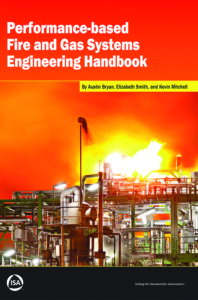Performance based Fire and Gas Systems Engineering Handbook
Performance based Fire and Gas Systems Engineering Handbook
Performance based Fire and Gas Systems Engineering Handbook are a subset of instrumented safeguards – instrumented systems, such as safety instrumented systems (SISs) or burner management systems (BMSs), that detect hazardous conditions, provide early warning, and take appropriate mitigation actions to safeguard people and assets. Implementing FGSs in a process plant has been a challenging endeavor for many years. Process plants – which can include a wide variety of industries such as oil and gas, refining, petrochemical, power generation, specialty chemicals, and pharmaceuticals – often present a much wider array of hazards than are encountered in traditional building fire protection engineering. Process plant hazards include fires, combustible gas releases, and the possibility of acute toxic gas hazards. The plant environment is often outdoors, which adds complexity in making informed decisions about hazard detection and mitigation.
You can also Read Handbook of Fire and Explosion Protection Engineering Principles
Performance based Fire and Gas Systems Engineering Handbook Content
- About the Authors
![Performance based Fire and Gas Systems Engineering Handbook]()
- Preface
- Introduction
- Lifecycle
- Starting Point: Requirement for FGS Evaluation
- FGS Philosophy Development
- Fire and Gas Zone Definitions
- Fire and Gas System Performance Targets
- Fully Quantitative Risk Analysis Approach
- Semi-Quantitative Approach
- Verifying Detector Coverage
- Verifying FGS Safety Availability
- FGS Requirements Specification
- Detailed Engineering Design
- Construction, Installation, and Commissioning
- Site Acceptance Test (Validation)
- Operation and Maintenance
- Management of Change.
- Appendix A – Abbreviations
- B – Definitions
- C – FGS Philosophy Considerations
- D – Zone Definition and Categorization
- E – Consequence Table
- F – Leak Frequency Tables
- G – Example Semi-Quantitative Approach
- H – Analytical Geometry Formulae
- I – Understanding Fire and Gas Mapping Software.
- J – Bibliography
The ISA technical report provides end-user companies with a risk based approach to fire and gas system (FGS) design that utilizes their guidelines for tolerable risk. The technical report allows for design flexibility; designs can be tailored to provide dependable risk reduction capability. Like safety instrumented systems (SISs), FGSs can be designed in a good, better, or best fashion, which matches system performance with the amount of risk reduction needed.


Comments are closed.